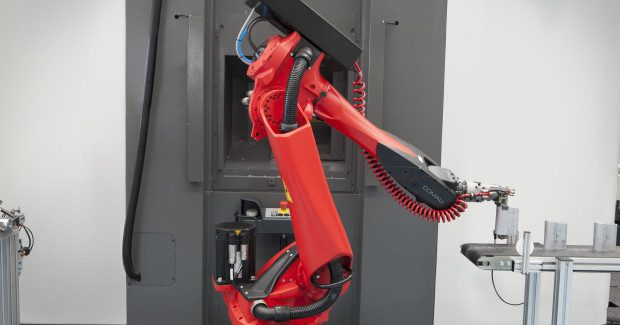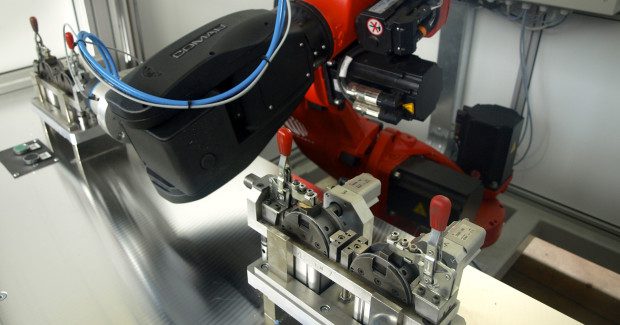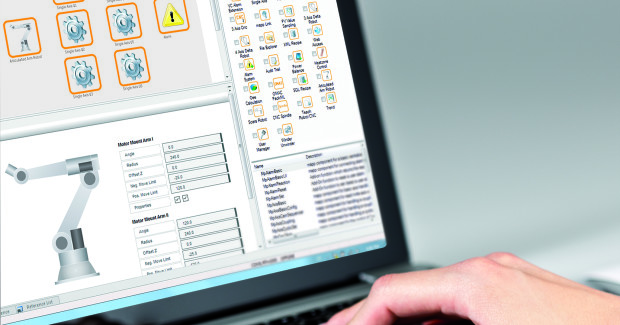All Over the Mapp
The next step in the Internet of Things is here. These robots and the machine tools they tend can use a single controller for automated interaction instead of separate units operated by different kinds of software that must communicate through a fieldbus. Now the same control system can manage both the machines and the robots of an automated plant.
Posted: November 13, 2015
Robot Arm is the name of 6-axis articulated robots from Comau SpA Robotics (Grugliasco, Italy) that are now offered without an attached C5G control unit. To operate, these machines use the same CPUs manufactured by Bernecker + Rainer Industrie Elektronik GmbH (B&R; Eggelsberg, Austria) that are installed in other machines within an automated plant and contain ready-to-use software functions designed to control 6-axis robots. The software technology from B&R is called mapp (modular applications), and it consists of a set of software component libraries that are integrated into the programming system Automation Studio. It is, in effect, a new software development philosophy that allows a 67 percent reduction in programming time.
The numerous function blocks of the mapp library include special blocks for the handling of Comau robots. During operation, mapp selects the desired function block from the library and configures it to carry out all of the most common steps of a specific automation application. “We started working with B&R in order to develop our C5G fifth-generation controller with our own specifications and software,” says Arturo Baroncelli, the manager of Comau Robotics and a team member of the project to jointly supply Robot Arm and mapp technology. “However, the market has been asking us for automated systems in which robots and machines can use a single controller, instead of separate units operated by different kinds of software that are required to communicate through a fieldbus. Thanks to a study we began with B&R two years ago, we can now offer just the mechanics of a robot – our Robot Arm – that is now able to be used without the control unit and can instead be controlled by standard hardware and software packages developed by our partners for this specific purpose.”
COMPLETE INTEGRATION
“Thanks to the use of mapp modules, it is possible to use the same control system to manage both the machines and the robots of an automated plant,” explains Marzio Grattieri, the sales director of B&R Italy. “In this way, the performance of the plant increases significantly because both machines and robots are perfectly integrated within the same project and managed by a single controller without the mediation of a communication bus. This perfect synchrony makes the machines more responsive and improves their performance. A single safeMotion system controls both the axes of the machine and those of the robot. Consequently, safe operating distances can be reduced, with enormous advantages in footprint terms. This allows significant operational benefits for both the manufacturers of automated machines and the end customers.”
In addition to the operational advantages are savings in floor space and plant realization costs due to a significant electrical panel reduction. In fact, the control cabinet that normally comes with the robot is no longer needed with this configuration because management electronics are inserted in the same cabinet as the machine to reduce wiring and increase energy savings thanks to the presence of a single shared power supply. Another advantage of using a single controller is a reduction in number and variety of the spare parts required for maintenance, which benefits the spare parts warehouse. Besides all of this, mapp requires a single development environment within which any one of the programming languages belonging to the IEC 61131-3 standard for the realization of specific functions of the machines can be used indifferently. This directly results in additional operational efficiency through the removal of double controllers programmed with different operating systems and software.
In fact, for all of the tasks that are common in automation applications, such as controlling robots, programming is not even needed. It is sufficient to configure the available mapp modules, which makes the automated system more intuitive and easier to handle for operators and developers.
A TAILORED ROBOT
The Robot Arm series consists of 26 robotic arms with capacities ranging from 7 kg to 650 kg that are now sold without the C5G controller, which means they can be considered standalone equipment that comes with a dedicated price list, as well as their own technical documentation. In agreement with B&R, Comau provides these Robot Arm machines already configured with four increasing levels of options. In their basic version, with motors, adapters and cables, the power supply and control interface of the Robot Arm is a distribution box located at the base of axis 1. Three additional configurations are also possible: one with external distribution cables of varying lengths, from 5 m, 10 m, 15 m, 20 m, 30 m or 40 m, that are connected to a control cabinet; another that features connectors at the base of the motor cabinet that also houses encoders and a fieldbus; and an additional version that comes with connectors at the base of the cabinet and 1.5 m long cables inside the cabinet itself.
THE CORE OF INTEGRATION
The mapp project is the result of a specific market need: speeding up the development of software and creating more and more modular and flexible packets. “Thanks to the use of this technology,” notes Andrea Guglielmi, a developer of the B&R mapp team, “programmers no longer have to spend time setting up the recurring functions of a machine. Instead, they have the opportunity to concentrate on their main task of implementing the machine or system processes within their own application software. The mapp modules cover most of the basic functions present in each machine. New features are also currently being developed and field tested, and will soon be released.”
The mapp blocks are perfectly integrated into the B&R automation software as libraries. This allows developers working with Automation Studio, B&R’s development environment, to implement modular software in order to make their work easier, and the application software more intuitive. “There are several advantages,” clarifies Guglielmi. “First and foremost, mapp blocks are directly written, tested and optimized by us before being released and are accompanied by documentation included in the user guide and by standard diagnostic components. This guarantees a higher quality of the code, software stability and a reduction in project management issues to the customer. Similar to any other standard product, we also take care of the maintenance of the modules, eliminating the time and costs associated with these operations that a company would incur if they developed the programming in-house.”
For these reasons, the mapp solution is an important tool to support the efficiency of manufacturers, who can now focus their developers on machine processes in order to enhance their own distinctive and competitive elements. The mapp technology also integrates blocks that perform advanced technological functions, which are presented to the programmer with a very user-friendly interface. This is a feature that simplifies the management of highly complex processes and further increases efficiency.
MEETING THE NEEDS
The co-developed project has already received a very positive response from both the Italian and foreign markets. “We have provided Robot Arm machines controlled by mapp modules to both Italian and foreign integrators, who have directly employed the robots in their plants,” states Baroncelli. “We are extensively testing the market with active cooperation agreements ranging from Southeast Asia to Latin America, Germany and, of course, Italy. Within Italy, multiple systems integrators use our Robot Arms in their own plants. This experience has encouraged our active and lasting partnership with B&R.”
“We have a well-established partnership with Comau,” explains Grattieri. “Numerous analysis of the business sector shows that we can meet the growing demand of robots in the coming years, even for applications and in industrial branches where they are traditionally used less. This is a direct consequence of the tendency of modern industry to process small batches or even manufacture single units. In this sense, the full integration of robotic mechanics with those of the other machines is a major advantage in terms of time and costs. Thanks to the Robot Arm and mapp projects, the control system of the machine can manage the axes of the machines, as well as the motors and the feedback of the robot with the same tools and software interfaces. All of this means a quicker setup, highly flexible production and shorter operational standby times, all to the advantage of production.”
BOX DEDICATED TO MACHINE TOOLS
Machine tools are more efficient with Robot Arm and the mapp technology. In an automated cell where there are robots and machine tools in joint processing, the adoption of the Robot Arm-mapp solution brings significant operational benefits to shops. “The software tools needed to run robotic kinematics are computationally and logically more complex than those used to control the activation of a standard machine tool,” explains Grattieri. “Mapp blocks, however, are effective in facilitating the development and management of the machinery, no matter how complex it may be. For example, let’s assume the Robot Arm and mapp solution is employed on-site by a shop that uses the robot to move a sheet of metal within an automatic working cell for the tending of a bending press. In this case, the application allows both the management of the kinematics of the robot and a perfect synchronization between the movements of the robot and those of the tool.
“The joint management of robot and machine through a single controller, created within a single development environment and a single programming language, simplifies the entire operating procedure and leads to a significant increase in performance,” continues Grattieri. “Furthermore, let’s not forget that the operators dedicated to setting up the machine tool cycle can also simultaneously program, within the same interface, the working cycle of the robot as well.”
As manufacturing enters the Internet of Things, the market opportunities for the Robot Arm-mapp solution are many because it can reinforce the presence of robots even in sectors where the need for greater operational flexibility and work speed is steadily increasing. It counters the difficulties facing the engineers who develop management software for machine tools but may not possess the experience needed to integrate robots into their plant operations. “Robot Arm and mapp provides the robotic mechanics that are able to integrate with their hardware and then manage through the modules of the mapp software,” concludes Grattieri. “As a result, controlling the entire plant becomes simpler and more intuitive.”
Comau SpA Robotics, Via Rivalta, 30 10095 Grugliasco (TO) Italy, +39 011 004 9111, www.comau.com.
Bernecker + Rainer Industrie Elektronik GmbH, B&R Str. 1, 5142 Eggelsberg, Austria, +43 7748 65860, www.br-automation.com.





















